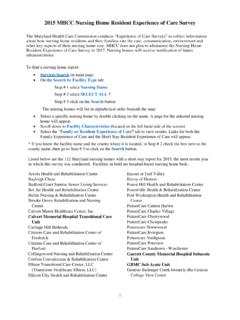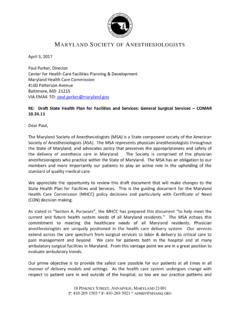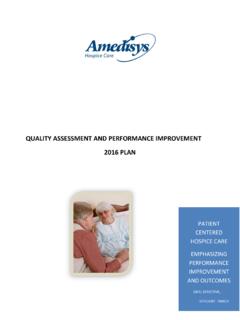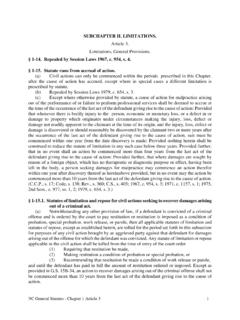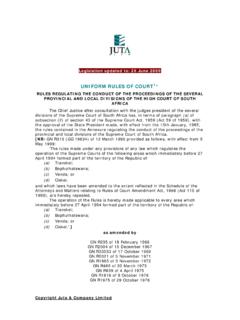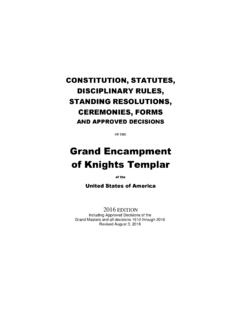Transcription of Certificate-of-Need Over Hospitals in Rhode Island: A ...
1 Certificate-of-Need Over Hospitals in Rhode Island: A Forty-Year Retrospective Gerard R. Goulet*. ABSTRACT. The health reform legislation debate of the past year has been heavily laced with rhetoric about our nation's historic and continuing failure to effectively contain health care costs. National health insurance proposals have surfaced periodically since the early 1930s. With the exception of Medicare and Medicaid, most have not survived the political gauntlet. Thirty- five years ago, the country seemed primed for change, but the political wisdom determined that system controls should be implemented before any movement was attempted in a direction akin to a national health insurance program.
2 That reform legislation - the last true attempt at substantive systemic interaction - lasted for only nine years before it was repealed. The only vestiges remaining, the Certificate-of-Need programs that continue to exist in select states, operate without much apparent impact on costs. This Essay will look at the history of certificate- of-need in Rhode Island, showing how its shortcomings were identified from a very early stage, and why its impact on cost has * Gerard R. Goulet is a partner with the firm of Hinckley, Allen & Snyder, , with offices in Massachusetts, Rhode Island, New Hampshire and Connecticut.
3 His primary practice area is health care. He served as the Chief Administrative Officer of the Rhode Island Certificate-of-Need program from 1978 through 1981 and has represented clients in Certificate-of-Need matters over the ensuing thirty years. The views expressed are those of the author, derived from his experiences as a regulatory attorney over that time period. 127. 128 ROGER WILLIAMS UNIVERSITY LAW REVIEW [Vol. 15:127. been minimal at best. In so doing, this Essay will also attempt to explain why Certificate-of-Need remains an annual lightning rod for spirited legislative debate despite the fact (or perhaps because).]
4 It has been a greater force for preservation of the systemic status quo than would likely have been the case had no such law been enacted. INTRODUCTION. One recurrent criticism of the effort to reform health care in 2009 has been the attention paid to expanding health insurance coverage in contrast with the scant relative attention paid to controlling health care costs. This criticism brings to mind the nearly reverse situation that characterized the last major attempt to achieve structural change to the health care system as a precursor to the adoption of a national health insurance program.
5 Thirty-five years ago, the National Health Planning and Resources Development Act of 1974 ("NHPRDA")i was enacted shortly after Congress came as close as it has in history to passing a true national health insurance act. 2 The goal of the NHPRDA. was to bring rationality to health care decision making by giving states monetary incentives to engage in planning, to implement capital expenditure controls through compliant Certificate-of-Need programs, to review federal grant-making and to initiate appropriateness review of existing health services.
6 3 The NHPRDA lasted less than ten years and left behind little trace other than Certificate-of-Need programs in half of the nation's states. 4 Originally instituted, at least in part, for reasons of cost containment, Certificate-of-Need programs provide little by way of 1. See generally Pub. L. No. 93-641, 88 Stat. 2225 (1974), amended by Health Planning and Resources Development Amendments of 1979, Pub. L. No. 96-79, 93 Stat. 592 (1979), partially repealed by Pub. L. No. 99-660 701, 100 Stat. 3743, 3799 (1986). 2. DAVID BLUMENTHAL & JAMES A.
7 MORONE, THE HEART OF POWER: HEALTH AND POLITICS INTHE OVAL OFFICE 244-47 (2009). 3. See Pub. L. No. 93-641, 88 Stat. 2225 (1974). 4. Id., amended by Health Planning and Resources Development Amendments of 1979, Pub. L. No. 96-79, 93 Stat. 592 (1979), partially repealed by Pub. L. No. 99-660, 701, 100 Stat. 3743, 3799 (1986). Those of us who lived through the repeal did not understand it to be a partial repeal. Certainly as to Certificate-of-Need there was no longer any federal money to support it. 2010] Certificate-of-Need OVER Hospitals 129.
8 Conclusive evidence of their power to constrain costs. Nonetheless, they continue to exist in states like Rhode Island. To understand the reasons for that continued existence, a review of the highlights of the Rhode Island program over the last forty years may be instructive. In reviewing the history of a program that has undergone so many legislative amendments over the course of its existence5 and that interconnects with, influences and is affected by so many other voluntary and mandatory planning and regulatory programs, the choice of highlights is personal and reflects my own views and not the views of any other individual.
9 I. CERTIFICATE OF NEED AS A REGULATORY CONCEPT. The franchising aspects of public utility regulation were first adopted under the rubric " Certificate-of-Need " in 1964 in the State of New York as a partial response to the perceived cost-accelerating overcapacity of facilities and equipment in the hospital The underlying (and somewhat flawed) premise of the regulatory scheme was that the major component of price increases in the health care sector was attributable to the non-payroll cost increases in rent, depreciation, interest, equipment and supplies which accompanied the overcapacity referred to above, which over-supply generated a self-fulfilling demand for use.
10 It was felt that only by the imposition of external controls, subjecting all significant investments to public scrutiny, would an alleviation of resource allocation inefficiency be assured. The mechanism, as designed, required review of health-related capital expenditures in Hospitals and other health care facilities to assure: (1) compliance with rational planning guidelines; (2) rational allocation of limited resources, with emphasis on satisfaction of a legitimate need as opposed to satisfaction of an induced demand; and (3) reduction of duplication and under-utilization.

